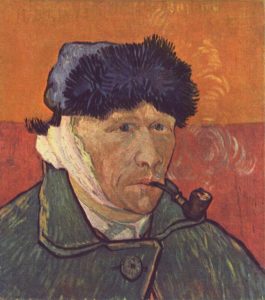Did Vincent VanGogh suffer from Irlen Syndrome?
Van Gogh suffered from a type of seizure disorder. During one episode, on December 23, 1888, he cut off his ear, and was then admitted to a psychiatric hospital and diagnosed with “acute mania with generalized delirium” and mental epilepsy. These attacks became more frequent by 1890, with the most severe episode lasting nine weeks beginning in March. Initial attacks of confusion and unconsciousness were followed by periods of stupor and incoherence, during which Van Gogh was generally unable to paint, draw, or even to write letters. Van Gogh was also known to use and abuse opium and alcohol, and possibly was addicted.
Van Gogh’s letters and other documents describe other symptoms including poor digestion, hallucinations, nightmares, manic/depressive episodes, stupor, extreme difficulty with relationships, absent mindedness, impotence, insomnia, and anxiety. Van Gogh suffered from hallucinations and nightmares at times. He often reported that he was suffering from fever. He was unable to sleep for three weeks prior to his diagnosis of gonorrhea in The Hague (sleeplessness and fever probably due to infectious disease). On occasions he sunk into a kind of stupor. Van Gogh reported his impotence to Theo, his brother. Van Gogh mentioned suicide several times in his letters towards the end of his life. His manic episodes feature reckless behavior, euphoria, and impulsiveness. Depressive episodes featured symptoms of depression, anger, indecisiveness, social withdrawal, and often recurring thoughts of death or suicide.
From a young age, van Gogh grew up with a strong connection to painting and religion. While living in London at age 20, he fell in love and when she refused his marriage proposal, he suffered his first mental breakdown. He decided at that time to devote his entire life to God and become a priest.
There was a family history of mental illness and van Gogh displayed symptoms of bipolar disorder, including reckless and indecisive impulsive behavior, which is considered to be genetically inherited. Van Gogh moved a lot due to sexual rejection for the next 10 years. In 1880 her moved to Brussels to become an artist and then Paris in 1886. Van Gogh indulged in activities which undermined his health, such as smoking, alcohol and coffee to excess, poor eating, and detrimental fasting which led to malnutrition. There is some evidence that van Gogh may have eaten paints which resulted in lead poisoning and seizures. In January 1890, after another one of Vincent’s seizures, Theo wrote to him saying “if you know that it is dangerous for you to have colors near you, why don’t you clear them away for a time, and make drawings? Your doctor stated that the paints were poisoning you.” His doctors diagnosed him with epilepsy that was controlled by bromide, which is effective against grand mal seizures, as well as absinthe intoxication and porphyria.
Van Gogh may also have also suffered from bipolar disorder or borderline personality disorder. His well-documented periods of intense activity interspersed with periods of exhaustion and depression, exacerbated by thujone poisoning from consumption of absinthe. He “displayed symptoms of impulsivity, variable moods, self-destructive behavior, fear of abandonment, an unbalanced self-image, authority conflicts and other complication in relationships.” Van Gogh’s “longings for love, his sudden mood changes (and most particularly his seemingly unpredictable and unwarranted rages), and his pattern of impulsive acts, including substance abuse, are all recognizable components of the borderline syndrome…
Van Gough may also have suffered from chronic sunstroke. He once wrote: “Oh! that beautiful midsummer sun here. It beats down on one’s head, and I have not the slightest doubt that it makes one crazy. But as I was so to begin with, I only enjoy it.” A month earlier he wrote his brother: “your letter arrived at the moment when I was still dazed with the sun and the strain of wrestling with a rather big canvas. Another theory is that Vincent may have suffered from Meniere’s Disease — a balance disorder of the inner ear, which is accompanied by nausea, vomiting, hearing loss, and vertigo and that Vincent’s cutting of his ear was an attempt at self-performed surgery to relieve the Meniere’s symptom of tinnitus.
He suffered the key symptoms of lead poisoning (anemia, stomatitis, abdominal pain, signs of radial neuropathy, etc.) and characteristics of saturnine encephalopathy while in a psychiatric hospital, along with states of delirium and seizures. He also had auditory hallucinations which were episodic, not chronic, suggesting that symptoms may have been triggered by environmental and biological stressors. Van Gogh suffered from anxiety, irritability, and non-suicidal self-injury, even before his infamous cutting off of his own ear.
Vincent and Theo suffered from symptoms of syphilis. Vincent was treated for gonorrhea in 1882 and neurosyphilis mental disorder, which occurs 10 to 20 years after infection. Van Gogh may have exhibited a form of digoxin toxicity from the foxglove plants used to treat his epilepsy. His yellow period (‘yellow vision’), missing ear (‘oto-toxicity’) and penchant for painting halos around landscape objects (‘halo vision’ suggest a visual sensory processing disorder known as Irlen Syndrome, or scotopic sensitivity or light sensitivity. To learn more about Irlen Syndrome and it’s effect on vision, hearing, attention, focus, reading, motor skills, emotional and cognitive functioning, immune system and other issues like dyslexia, ADD/HD, anxiety, depression, visual distortions, and chronic headaches/migraines, see www.irlensyndrome.org. Also visit my website for many free resources, pre-screening symptom checklists, research, videos, client testimonials and professional trainings www.aotss.com. If you or someone you know may suffer from Irlen Syndrome, go to our contact us form and we will return your request for information and provide a free 15-minute phone consultation.


